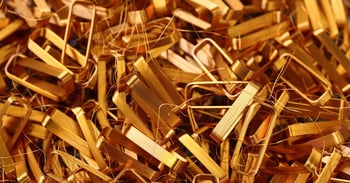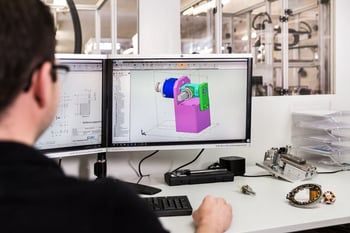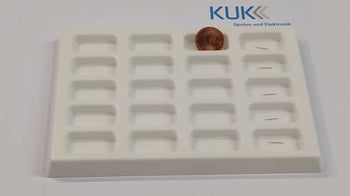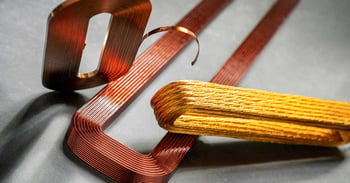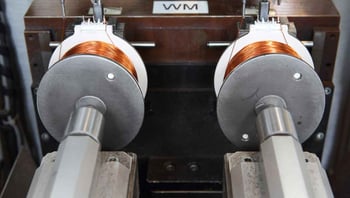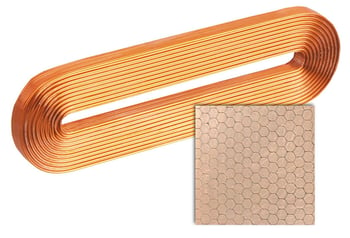Insulation layer on magnet wires: A common stumbling block for engineers
In coil production, the insulation of the wire has an influence on a wide variety of product properties such as application range, service life, costs or coil design. Wire insulation also has an effect on various factors during coil manufacturing, such as scrap or further processing. This article summarises the essential facts about wire insulation - and its effect on coil design - for engineers.
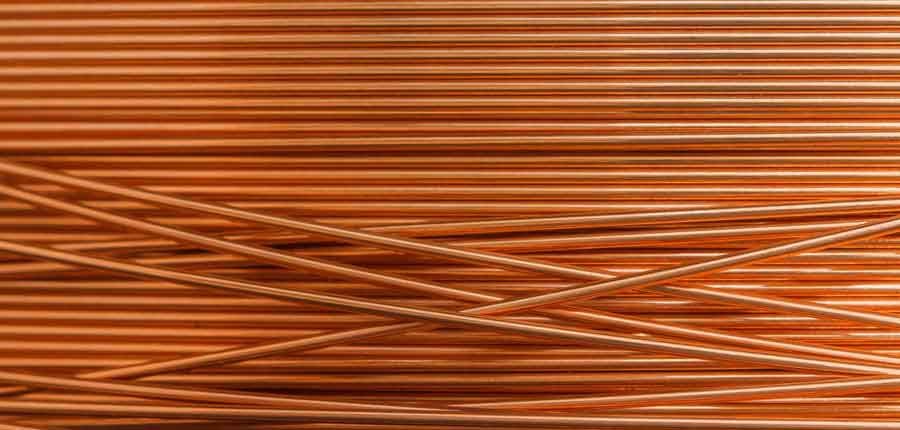
First, briefly on the question of why wire needs to be insulated at all: The magnet wire insulation is what ensures that the current flows through each turn without shorting. The insulation is necessary so that the number of turns N in all the formulas for the magnetic field makes sense. In addition, the insulation layer protects against short circuits.
What grades of insulation are available in enamelled copper wire for coil manufacturing?
The insulation layer thicknesses and the corresponding electrical efficiencies are divided into degrees. Depending on the grade, there is a different ratio of copper cross-sectional area to total cross-sectional area. The insulation grades describe a minimum and a maximum value for the increase of the layer thickness. According to the common IEC 60317 standard, grade 1 has the thinnest and grade 3 the thickest insulation layer. However, wires with thinner or thicker insulation or reduced tolerances are also available on a customer-specific basis.
In many calculations, the enamel layer is not taken into account and the effective outer diameter is therefore calculated too tightly.
As shown in this table by the fine wire manufacturer Elektrisola, a 0.100 G1 wire with 0.1 mm copper and an insulation layer has an effective outer diameter of 0.108 mm to 0.117 mm.
| Nominal | Grade 1 | Grade 2 | Grade 3 |
|---|---|---|---|
| 0.100 | 0.108 - 0.117 | 0.118 - 0.125 | 0.126 - 0.132 |
Source: Elektrisola
What are wire enamels?
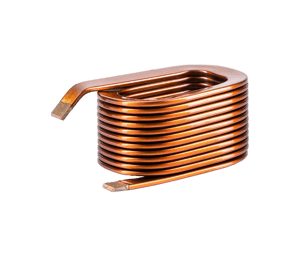 Wire enamels, also known as primary insulation, are used on round and flat wires made of copper and aluminium in motors, transformers, generators and electrical measuring equipment. They are cured by heat on the wires and their main function is to provide electrical insulation. Wires coated in this way are also called "magnet wires" or "winding wires". These wire enamels must sometimes have very good chemical and thermal resistance, adhere very well to copper or aluminium wire and have excellent mechanical stability.
Wire enamels, also known as primary insulation, are used on round and flat wires made of copper and aluminium in motors, transformers, generators and electrical measuring equipment. They are cured by heat on the wires and their main function is to provide electrical insulation. Wires coated in this way are also called "magnet wires" or "winding wires". These wire enamels must sometimes have very good chemical and thermal resistance, adhere very well to copper or aluminium wire and have excellent mechanical stability.
The wire enamel is applied differently depending on the shape and diameter of the wire to be coated. Horizontal or vertical application or application with nozzles or with felts are typical wire coating processes.
What are the most common materials for wire insulation in coil production?
The choice of insulation materials is very wide, with the majority being based on resins. Depending on the application, a different insulation class must be chosen, which refers to the thickness and material of the insulation layer. The design of the insulation plays a subordinate role for the processing of the wire, apart from the lubricant.
Chemically, the wire enamel range consists of:
- Polyurethanes, solderable enamels,
- polyesterimides, heat-resistant enamels,
- polyester amide imides, solvent-resistant enamels
Below is a more detailed description of the most common uses of various insulation materials for coil production:
Polyurethane wire enamels (PUR)
Wires insulated with polyurethane varnishes have good solderability at 375°C. Special formulations result in excellent crack and pinhole resistance. These wire enamels are mainly used in small transformers, timers, relays, small motors, solenoids, clock coils, flyback transformers, magnetic heads or automotive coils such as relays and ignition coils.
Solderable polyesterimide wire enamels (PEI)
Solderable polyesterimide wire enamels can be soldered even at temperatures above 450 °C in some cases. The coated magnet wires have good elasticity as well as good dielectric and mechanical properties. These coatings are particularly suitable for small electric motors to connect the windings to the collector. Polyesterimide wire enamels are often used on winding wires for relays, small transformers, small motors, circuit breakers, ignition coils, magnetic switches and in automotive applications.
THEIC polyesterimide wire enamels (TPEI)
THEIC polyesterimide wire enamels are very heat resistant and have very good mechanical, electrical and chemical resistance. These wire enamels are commonly used on wires in electric motors, refrigeration equipment, transformer windings and fluorescent lamp ballasts.
Polyamideimide wire enamels (PAI)
Polyamideimide wire enamels can be used as either single or double enamels; both options provide excellent mechanical properties and the highest chemical resistance. In addition to the classic polyamideimide coating, wire enamels with integrated lubricant for increased winding speed are also available. These products are used specifically for coating wires in electric motors, refrigeration systems, transformer windings, solenoid valves and ballasts for fluorescent lamps.
Self-bonding wires
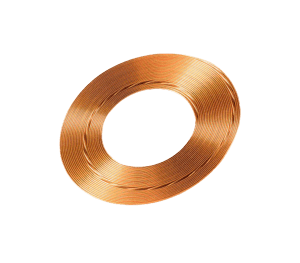
A further type of wire is self-bonding enamelled wire, which contains a second layer of enamel. However, this so-called self-bonding overcoat is not used for insulation, but for the mechanical stability of a coil. The self-bonding enamel layer is based on epoxy resins, polyvinyl butyral or polyamide. In addition to the technical requirements, the preferred bonding process is decisive for the selection. In the bonding process, the windings are thermally or chemically bonded together, for example for self-supporting windings such as air core coils. Likewise, different types of self-bonding enamel are available depending on the continent.
Baked enamel wires, like the enamelled wires mentioned above, are not only available with copper as the conducting material, but also with alloys, aluminium or copper-clad aluminium, among others, for lightweight coils or high-strength conductors for better durability. Self-bonding enamel is mainly used for coils in measuring instruments, voice coils (such as loudspeakers), small motors and sensors.
In a nutshell: Wire insulation for coil winding
The variety of insulation materials or the possibility to integrate a lubricant into the insulation make the best choice for an application complex. Based on years of experience in customer-specific projects, a leading coil manufacturer like KUK Group can offer the best advice here. For engineers, it is particularly important during the development phase to consider the insulation layer in addition to the pure conductor material. This is an important prerequisite for a correct coil design.


